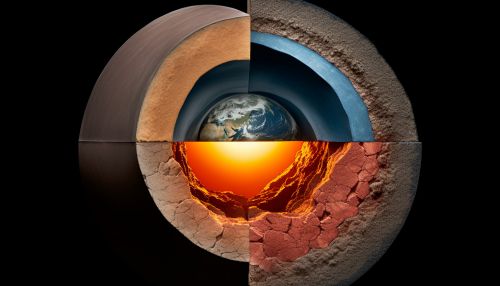Earths Geology
Introduction
Earth's geology, the scientific study of the solid Earth, its rocks, and the processes by which they change, is a vast and complex subject. It encompasses the study of Earth's lithosphere, crust, mantle, and core, as well as the processes that have shaped these structures over billions of years.
Earth's Structure


The Earth is divided into three main layers: the crust, the mantle, and the core. Each of these layers has unique properties and compositions, and they interact in complex ways to shape the Earth's geology.
The Crust
The Earth's crust is the outermost layer, composed primarily of igneous, metamorphic, and sedimentary rocks. It is divided into two types: the oceanic crust, which underlies the ocean basins, and the continental crust, which makes up the continents.
The Mantle
Beneath the crust lies the mantle, a layer of silicate rock approximately 2,900 kilometers thick. The mantle is divided into the upper and lower mantle, with the asthenosphere—a region of partially molten rock—serving as the boundary between them.
The Core
The Earth's core is composed primarily of iron and nickel and is divided into two parts: the liquid outer core, which borders the mantle, and the solid inner core. The interaction between these two parts creates the Earth's magnetic field.
Geological Processes
Earth's geology is shaped by a variety of processes, including plate tectonics, volcanism, and erosion. These processes are driven by the heat energy from the Earth's core and the Sun, and they continually reshape the Earth's surface.
Plate Tectonics
Plate tectonics is the theory that the Earth's lithosphere is broken into a number of tectonic plates that float on the semi-fluid asthenosphere beneath. These plates move due to the heat energy from the mantle, causing earthquakes, volcanic activity, and the creation of mountain ranges.
Volcanism
Volcanism is the process by which magma from the Earth's mantle rises through the crust and is expelled onto the surface as lava. This process is responsible for the creation of new crust and the shaping of many of the Earth's surface features.
Erosion
Erosion is the process by which the Earth's surface is worn away by natural forces such as wind, water, and ice. This process shapes the Earth's surface features and creates sediment, which is transported and deposited in new locations.
Geological Time Scale
The geological time scale is a system of chronological dating that relates geological strata to time. It is used by geologists to describe the timing and relationships of events in Earth's history.
